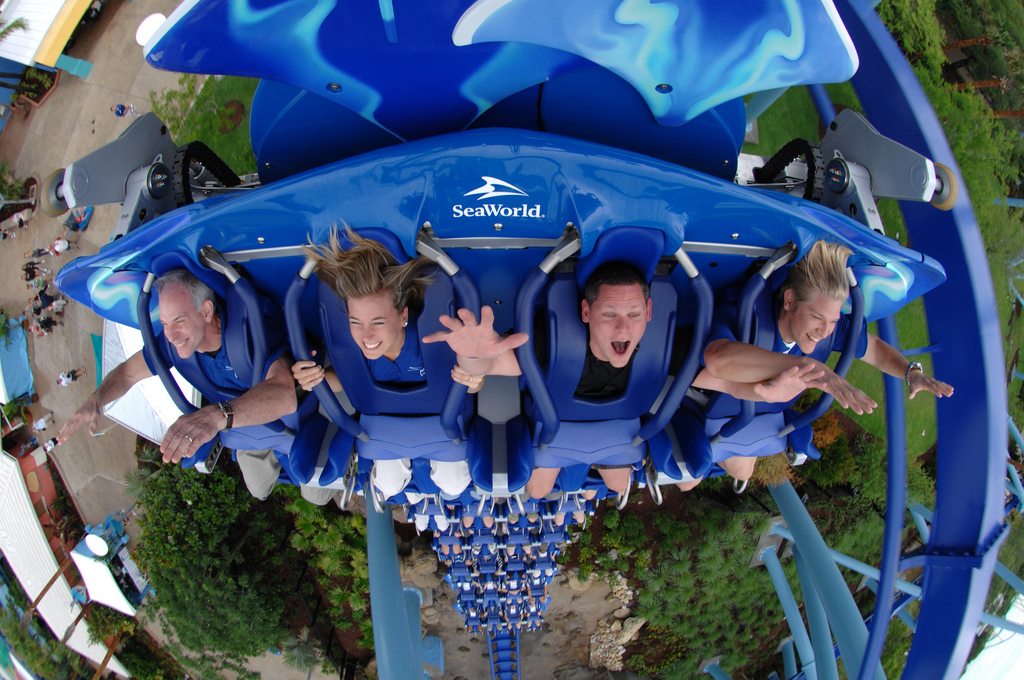Skift Take
SeaWorld has talked for nearly a year about how public perception of the company is improving. The trick seems to be turning that attitude into attendance.
By just about every measure, SeaWorld Entertainment had an epically bad 2016.
Attendance plunged, revenue dropped, and the previous year’s profits fizzled into a loss. The lackluster results, released Tuesday, came as the Orlando-based theme park operator transitions away from its famous Shamu shows to “experiences that matter.”
“We are intensifying our focus on execution,” president and CEO Joel Manby said during a call with analysts. “With our brand evolution well underway, our full attention, energy, and resources are focused on running the business with maximum efficiency to generate improved results.”
Last year’s results were not an improvement from 2015. Attendance dropped by about 471,000 visitors to 22 million, largely due to declines in Florida. Revenue fell from $1.37 billion to $1.34 billion. And while SeaWorld reported $49 million in profits in 2015, the company swung to a $12.5 million net loss last year.
During the fourth quarter, attendance dropped by 30,000 in part because of Hurricane Matthew. Quarterly revenues dropped slightly to $267.6 million, while losses reached $11.9 million. Texas and California parks saw attendance improve.
Tuesday’s numbers confirmed what the company foreshadowed when it released preliminary results earlier in February. Those details came out early in connection with a potential debt refinancing transaction.
Last year’s revenue was the lowest since at least 2012, the year before SeaWorld’s initial public offering. Attendance has also not been this low in SeaWorld’s history as a publicly traded company. Previously, attendance fell to 22.4 million in 2014 before inching up to 22.47 million in 2015.
SeaWorld has not had a good year for a long time. After the critical documentary Blackfish was released in 2013, public sentiment shifted against the company’s handling of killer whales.
After bungling its response to the public relations crisis, SeaWorld replaced the CEO and early last year announced an end to its orca breeding program and theatrical performances. Those have already been phased out in favor of more nature-based encounters in San Diego, while other parks will follow in the coming years.
Still, Manby signaled that the company is still in an early stage — “about the second inning” — of changing its image. SeaWorld hired a new chief marketing officer last year to help that campaign move forward.
“I’m very enthused about what’s happening in our company and what we see,” he said. “We are looking at very effective ways to combine our public relations efforts with our marketing efforts so when we’re selling our tickets, we’re also telling a good story about our brand.”
Over the past year, the company has tried to shift its focus to rides and non-animal attractions, but crowds remained elusive. Brazil’s faltering economy was partly to blame, executives said, keeping Brazilian visitors away from parks in Orlando and Tampa. And Manby said that the Orlando market overall was soft.
Late last year, the company announced a series of cost-cutting measures and eliminated 320 positions across its 12 parks and headquarters.
Despite the difficult year that just ended, Manby said he expects to see Florida — which has been the main drag on the company — improve in 2017.
The company is not expecting huge slides in Latin American attendance again.
“We are seeing the stabilization of Latin America,” said chief financial officer Peter Crage. “It’s not getting worse. But on the other hand, we don’t expect it to ramp up very quickly.”
SeaWorld doesn’t have much to add to its Orlando park this year aside from a new virtual reality component to an existing roller coaster. But Manby said he expects to benefit from crowds generated by competitors.
Disney’s Animal Kingdom is opening a new Avatar attraction in May; Universal Studios will also debut a new water park at the time.
“I’m looking forward to good product from Disney [and] Universal to add to our good product,” Manby said.
He said SeaWorld plans to continue to seek out guests who want to spend less on a theme park experience than they would at the larger rivals.
“We have a strategy that we can compete with Disney/Universal because we’ve always had a good value proposition,” Manby said. “We are increasing our value proposition.”
The Daily Newsletter
Our daily coverage of the global travel industry. Written by editors and analysts from across Skift’s brands.
Have a confidential tip for Skift? Get in touch
Tags: seaworld, theme parks
Photo credit: Riders are shown on the Manta roller coaster at a SeaWorld park. Parent company SeaWorld Entertainment reported that revenues, profits, and attendance fell in 2016. Ted Murphy / Flickr
